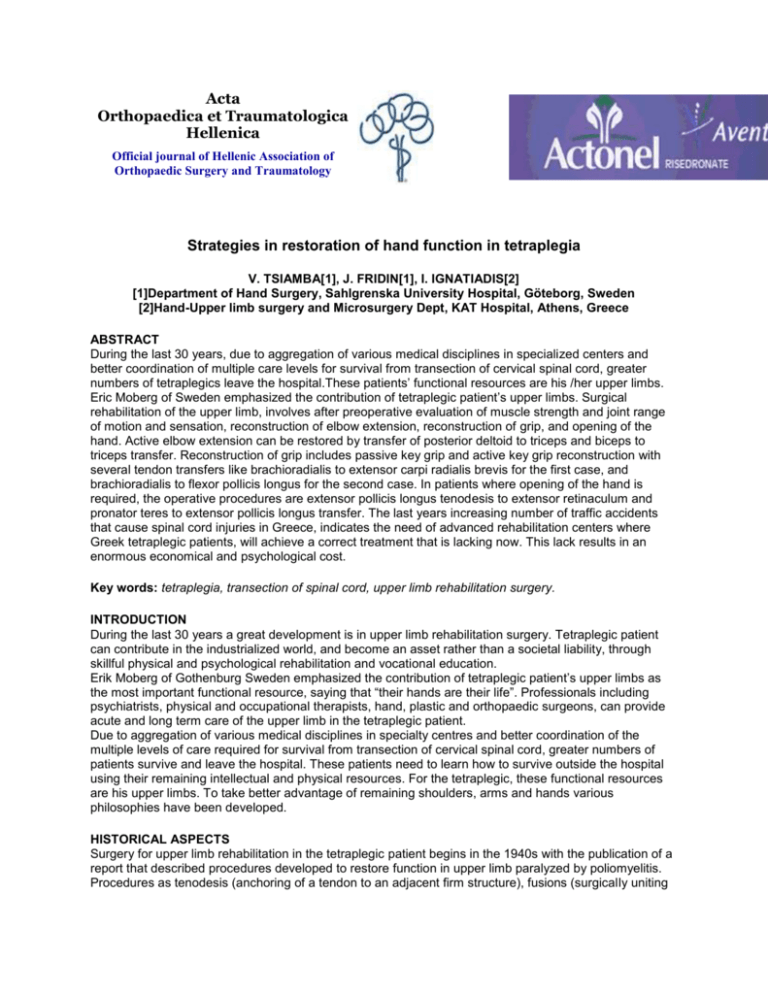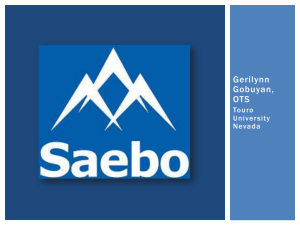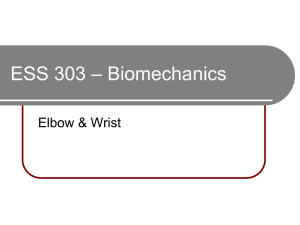Acta Orthopaedica et Traumatologica Hellenica Official journal of
advertisement

Acta Orthopaedica et Traumatologica Hellenica Official journal of Hellenic Association of Orthopaedic Surgery and Traumatology Strategies in restoration of hand function in tetraplegia V. TSIAMBA[1], J. FRIDIN[1], I. IGNATIADIS[2] [1]Department of Hand Surgery, Sahlgrenska University Hospital, Göteborg, Sweden [2]Hand-Upper limb surgery and Microsurgery Dept, KAT Hospital, Athens, Greece ABSTRACT During the last 30 years, due to aggregation of various medical disciplines in specialized centers and better coordination of multiple care levels for survival from transection of cervical spinal cord, greater numbers of tetraplegics leave the hospital.These patients’ functional resources are his /her upper limbs. Eric Moberg of Sweden emphasized the contribution of tetraplegic patient’s upper limbs. Surgical rehabilitation of the upper limb, involves after preoperative evaluation of muscle strength and joint range of motion and sensation, reconstruction of elbow extension, reconstruction of grip, and opening of the hand. Active elbow extension can be restored by transfer of posterior deltoid to triceps and biceps to triceps transfer. Reconstruction of grip includes passive key grip and active key grip reconstruction with several tendon transfers like brachioradialis to extensor carpi radialis brevis for the first case, and brachioradialis to flexor pollicis longus for the second case. In patients where opening of the hand is required, the operative procedures are extensor pollicis longus tenodesis to extensor retinaculum and pronator teres to extensor pollicis longus transfer. The last years increasing number of traffic accidents that cause spinal cord injuries in Greece, indicates the need of advanced rehabilitation centers where Greek tetraplegic patients, will achieve a correct treatment that is lacking now. This lack results in an enormous economical and psychological cost. Key words: tetraplegia, transection of spinal cord, upper limb rehabilitation surgery. INTRODUCTION During the last 30 years a great development is in upper limb rehabilitation surgery. Tetraplegic patient can contribute in the industrialized world, and become an asset rather than a societal liability, through skillful physical and psychological rehabilitation and vocational education. Erik Moberg of Gothenburg Sweden emphasized the contribution of tetraplegic patient’s upper limbs as the most important functional resource, saying that “their hands are their life”. Professionals including psychiatrists, physical and occupational therapists, hand, plastic and orthopaedic surgeons, can provide acute and long term care of the upper limb in the tetraplegic patient. Due to aggregation of various medical disciplines in specialty centres and better coordination of the multiple levels of care required for survival from transection of cervical spinal cord, greater numbers of patients survive and leave the hospital. These patients need to learn how to survive outside the hospital using their remaining intellectual and physical resources. For the tetraplegic, these functional resources are his upper limbs. To take better advantage of remaining shoulders, arms and hands various philosophies have been developed. HISTORICAL ASPECTS Surgery for upper limb rehabilitation in the tetraplegic patient begins in the 1940s with the publication of a report that described procedures developed to restore function in upper limb paralyzed by poliomyelitis. Procedures as tenodesis (anchoring of a tendon to an adjacent firm structure), fusions (surgically uniting two bones by removing intervening joint) and muscle-tendon transfers (by redirecting the action of a donor muscle and its tendon), were performed. However in this period literature there is little mention of the role of upper limbs surgery. Sterling Bunnell, hand surgeon in USA with his classical work published in 1944[1] had a great influence as a teacher in hand reconstruction. He recognised that the wrist is the key joint of tetraplegic hand. He also recommended the creation of a pinch[2] between the tip of the thumb and tips of the index and middle finger. For tetraplegics functioning at C6-C7 level (ability to extend the wrist actively), he recommended tenodesis of finger and thumb flexor tendons to the radius. A third tenodesis attached the thumb to the ulna so that with voluntarily wrist extension automate fingers flexion and rotation of the thumb occurredto oppose index and middle fingers. For C7-C8 functioning level Bunnell recommended multiple muscle-tendon transfers. Bunnell and others achieved useful results in short term but long term results went unreported. During 40s and 50s Henry indicated the automatic hand grasp[3]. In 1956, Wilson reported the index finger powered by transfer of pronator teres as a trigger finger[4]. In 1959, Street reviewed the various methods of restoration of upper limb function and after 17 operations in 12 tetraplegics (between 1949 and 1957) he used transfer of the BR for many purposes[5]: • thumb flexor distal to the tenodesis • extensor mechanism to assist finger opening • the thumb flexor to provide voluntary lateral or key pinch • the thumb extensor to keep the thumb outside of finger grasp. Nickel et al. from Rancho Los Amigos Center in California reported the “flexor-hinged” hand procedure, and developed an orthosis that positioned the thumb and fingers similarly to the surgical procedure6. The brace was to be used for particular period of time and the patient should be made aware of this. During the 1960s and 1970s few surgeons continued to perform surgical reconstruction of upper limb function. Only those surgeons fortunate enough to work in specialty centers in which itch access made them able to generate sufficient numbers of cases for analysis, publication and recommendations. In 1967, Alvin Freehafer, working in Cleveland USA, was the first to advocate extensive proximal dissection of BR muscle as part of the preparation for transfer[7]. In1971, Douglas Lamb of Edinburgh, Scotland, after performing 72 muscle tendon transfers, was the first to advocate preferential restoration of a side or key pinch rather than opposition pinch[8]. In 1975, Eduardo Bacilli, from Buenos Aires, Argentina, published analysis of 97 tetraplegic patients studied between 1947 and 1974[9]. Seventy-six of these underwent surgery. He recommended a two-stage approach for each hand[10]. The initial stage provided extension or opening of the hand and the second, closure of the hand. He advocated looking for extra muscles at the first operation so that they could be used in the second procedure. The first procedure involved fusion of the thumb cmc joint and transfer of the BR muscle to the thumb and finger extensors. The second procedure involved transfer of extensor carpi radialis longus to the digital flexor tendons and transfer of the supernumerary muscle to the thumb flexor to the remaining radial wrist extensor. Zancolli did not provide any information regarding the functional results of his procedures. Erik Moberg of Gothenburg Sweden, contributed in surgical rehabilitation of tetraplegics enormously, introducing in 1975 the philosophy of restoring one prime hand function[11], a simply achieved key type pinch between the pulp of the hand and the side of the index finger, rather than more complicated opposition pinch preferred by his surgical predecessors. He followed the suggestion of Merle d’Aubigne et al.[12], who first proposed using part of the deltoid muscle to restore another useful function in this population, active elbow extension by transferring the posterior half of the deltoid muscle into the triceps. His basic philosophy remains the foundation of surgical decision-making today. PLANNING OF RECONSTRUCTION Before performing surgical rehabilitation of the upper limb, care must be taken to preserve the health of the upper limbs in the acute injury period (0-6 weeks). The principal therapy includes preventing and treating hand edema, maintaining supple joints and controlling pain and spasticity. Preoperative evaluation of the upper limb includes muscle strength tests, joint range of motion tests, and sensation testing. Muscle testing is performed according to the British Research Council system and the assessment of tetraplegia function groups that was modified at the 6th International Tetraplegia Meeting (1998, Cleveland Ohio). The basic procedures for reconstruction in tetraplegia include reconstruction of elbow extension, of grip function and opening of the hand. Restoring active elbow extension for the spinal cord injury patient in terms of locomotion, transfers accurately positioning the arm in space and improves the effect of more distal tendon transfers to restore hand function. RECONSTRUCTION OF ELBOW EXTENSION Nowadays, two surgical procedures are advocated to restore active elbow extension. One is to transfer posterior deltoid into the triceps and the other is to transfer the biceps muscle into the triceps. Posterior deltoid to triceps transfer is potentially indicated in patients with C5 and C6 level tetraplegia, to replace lost elbow extension[13-21]. Patients-candidates for the biceps to triceps transfer usually demonstrate intact and functional brachialis and supinator muscles, biceps spasticity and elbow flexion contracture exceeding approximately 20°. In posterior deltoid to triceps transfer, through an S-shaped incision over the posterior aspect of the posterior deltoid portion is mobilized, and detached, along with the associated periosteum. Anterior tibialis tendon is harvested and cut at the myotendinous junction, and removed through an anterior incision on the distal portion of the lower leg. A subcutaneous tunnel is created from deltoid insertion to the distal triceps tendon, via a dorsal incision to the level of olecranon. Distal deltoid muscle and tendon graft are placed with a 5 cm overlap and sutured to each other. Biceps to triceps transfer is performed through an S-shaped incision along the medial aspect of the arm, horizontally at the anterior crease of the elbow, and then vertically along the proximal forearm, over the brachioradialis muscle belly. The biceps tendon is freed to its insertion into the radius and then transected as close to the bone and as far distally as possible. Proximal dissection of the biceps muscle belly and raising of the vascular pedicle is performed. In order to expose the triceps muscle and aponeurosis a posterior S-shaped incision is made on the dorsal aspect of the arm's distal third. Through a wide tunnel under the deep fascia of the medial aspect of the arm, biceps tendon is sutured into the triceps tendon, and secured with 2/0 non-absorbable, running sutures, along the sides of the graft and recipient tendons and with a 5 cm minimum overlap. The transfer tension is set to the maximum while the elbow is held in full extension, so that the elbow cannot be flexed passively beyond 30° when the arm is abducted 30°. Along arm a synthetic splint is applied to keep the elbow in 10o of flexion and the wrist in 30° extension. For both procedures the arm is immobilized for 4 weeks to achieve adequate healing of the tenorhaphy sites. After 4 weeks and removing of brace and sutures an elbow angle orthosis is applied for 8 weeks more, and elbow flexion 10° every week starting from 30° is performed. RECONSTRUCTION OF GRIP FUNCTION Next basic procedure for reconstruction in tetraplegia is grip restoration. Tetraplegic patients mostly have a spontaneous weak pinch grip between the thumb and index finger, depended on wrist extension. So, in order to obtain a useful handgrip, preoperative planning must be based on patient’s goals and wishes and on thorough testing of muscle sensibility and spasticity of the hand. For a normal grip function, wrist extension is fundamental. If there is a lack of this function, reconstruction must be performed by transferring brachioradialis to wrist extensors[22]. Because of the use of brachioradialis as a wrist extensor, an antagonist is required in terms of an elbow extensor. Therefore, this transfer must be preceded by reconstruction of an elbow extensor. This procedure includes brachioradialis release of radial styloid (figure 1A) and connection with the two wrist extensors (Extensor Carpi Radialis Longus and Extensor Carpi Radialis Brevis), (figure 1B). 1A. Figure 1. A. Brahioradialis release of radial styloid. 1B. Figure 1.B. Brahioradialis connection with the Wrist extensors (ECRL and ECRB). The tension should be sufficient to hold the wrist in neutral flexion – extension (figure 2) but still permits complete passive flexion. Postoperatively, the arm is placed in cast above the elbow, to MetaCarpoPhallangeal (MCP) joints. The cast must be kept on for 4 weeks. For the next 4 weeks the use of the splint gradually reduces, but keeps on during night time. After two months the patient is free during day. After achieving wrist extension (spontaneously or through a brachioradialis transfer), it is possible to give the patient a key or thumb grip. This grip is based upon the fact that hand opens by passive or active wrist flexion and closes by wrist extension whereby the thumb pulp ideally should meet the radial side of the index finger middle phalanx. Key grip can be passive or active. Figure 2. The tension should be sufficient to hold the wrist in neutral flexion-extension, permiting a complete passive flexion. Passive key grip prerequisites are wrist extension, minimum strength grade 3, forearm pronation and good relationship between thumb and index/long finger. The technique consists of: • Split distal tenodesis of flexor pollicis longus (radial part)[23,24] to the Extensor Policis Longus (EPL) tendon over the IP joint (figures 3A, 3B, 3C). Tension is adjusted so that InterPhallangeal (IP) joint should flex 30° (figure 4). Figure 3. A. Split distal tenodesis of flexor pollicis longus (radial part) to the EPL tendon over the IP joint (Step 1). Figure 3. B. Split distal tenodesis of flexor pollicis longus (radial part) to the EPL tendon over the IP joint (Step 2). Figure 3. C. Split distal tenodesis of flexor pollicis longus (radial part) to the EPL tendon over the IP joint (Step 3). Figure 4. Tension is adjusted so that IP joint should flex 30°. • Tenodesis of the flexor pollicis longus to radius volar aspect. Erik Moberg's original method[25] consists of creating a channel through radius cortex by making two holes volary and connecting them. Then the Flexor PolicisLongus (FPL) is pulled in and out of this canal by means of a loop of a 0.5 mm ceirclage wire and finally sutured to itself. Tension must be so that the thumb is resting against the radial side of the index with the wrist in neutral position. • Arthrodesis of the thumb CarpoMetaCarpal (CMC) joint. Whenever the joint is very mobile the thumb may not meet the meet the index finger adequately. Stabilization is performed through a longitudinal dorsal incision, using two k-wires inserted from distal to proximal into the trapezium with an angle 60o70o. X-ray control reinsures that the wires do not penetrate the scaphotrapezial joint. Fixation is completed using two small staples. Postoperatively, hand and forearm must be immobilized in a cast for 3-4 weeks. Then active use of the acquired grip is started with gradual increase of load. To prevent contractures of the fingers pip joints a night splint is used. After arthrodesis of CMC joint the patient is equipped with a well-fitted orthosis or cast of fibreglass, stabilizing the first metacarpal in relation to the other four metacarpals, allowing full range of motion in the wrist and MCP joints. This orthosis or cast is used for up to 8 weeks postoperatively. Active key grip can be achieved by: • Transfer of the brachioradialis to FPL tendon, by passing the Brahioradialis (BR) through FPL once and then by a side-to-side anastomosis 5 cm long. Tension must be evaluated with the elbow flexed 90° and adjusted so that the thumb rests against the index finger with very light tension, holding the wrist in a neutral position. • Split thumb tenodesis. • CMC- I arthrodesis. Postoperatively the hand and forearm are immobilized in a plaster holding the wrist in 10-20° of volar flexion. The day after surgery a removable splint replaces the cast and intermittent exercises are started to activate brachioradialis. Four weeks postoperatively active use of grip is started using a splint during the night. The load is then gradually increased up to three months postoperatively. Reconstruction of finger flexion is possible mainly in patients with arms classified as minimum, group 4 (OCu:4) of the international classification. This reconstruction can be achieved by transferring Extensor Carpi Radialis Longus (ECRL) to deep finger flexors. Table 1. Strategies in surgical reconstruction of upper limb's function. RECONSTRUCTION OF OPENING OF THE HAND Reconstruction of opening of the hand is necessary in patients with finger flexors spasticity, in order to start operative treatment by opening the hand. This can be passive, by performing Extensor Policis Longus (EPL) tenodesis to extensor retinaculum and active. In active hand opening pronator teres is transferred to EPL. Except the above-described procedures, we must recognise that surgical rehabilitation can also be performed, in few patients with high-level injuries (Group IC0). For instance, the posture of a supinated but not contracted forearm is a disabling state, because this patient cannot with any orthosis, guide any utensil towards the mouth and is then dependent on others for several aspects of self care. If the supinated forearm can be passively pronated, muscle balancing by rerouting the biceps is possible. The biceps tendon is detached from the tuberosity of the radius and rerouted about the radius so that contraction of the biceps can now cause pronation of the forearm. For stronger IC Group 2 patient with preoperative good (MRC 4) wrist extension, an active key pinch can be possible, by transfer of the brachioradialis to the FPL[26]. The patient can then be able to affect a pinch in many wrist positions but will reflexively extend the wrist to augment the power of pinch. BR is exposed through a long incision and dissected, FPL is identified through the same incision in the volar forearm and then divided at its muscle -tendon junction and the two tendons are directed in a straight a line as possible toward one another. The tendons’ ends are passed through one another several times, interweaving them. Postoperatively the limb is immobilized in a below elbow cast that maintains the wrist in neutral position and the thumb MCP joint in some flexion for four weeks. After four weeks the cast is removed and a splint is constructed to keep the initial wrist and thumb position. At the fifth postoperative week the patient is encouraged to start grasp practice. Finally, in strongest patients (Group 6) some intrinsic function of the thumb can be restored (volar abduction) by transferring Extensor Digiti Quanti (EDQ) to Abductor Policis Brevis (APB). IMPLICATIONS FOR GREECE In Greek reality random surgical rehabilitation of patients with spinal cord trauma is provided. Unfortunately, because of lack of advanced rehabilitation centers tetraplegic Greek patients achieve an advanced operative treatment in centers abroad, like in Sweden, having this way an enormous economical and psychological cost. The establishment of an upper limb team consisting of hand and orthopaedic surgeons, physiatrists, physical therapists and psychiatrists is crucial after the last years' increasing number of traffic accidents that cause spinal cord injuries. The contribution of such a center in society could be significant because, aside the brain, tetraplegic patient’s upper limbs represent their most important functional resource. “Their hands are their life” has proven more important than the return of bowel and bladder, legs and sexual function. Special Olympics can prove that. REFERENCES 1. Bunnell S. Surgery of the Hand. Philadelphia: JB Lippincott, 1944. 2. Bunnell S. Tendon transfers in the hand and forearm. American Academy of Orthopaedic SurgeryInstructional Course Lectures. St Louis CV Mosby 1949; 102-112. 3. Hendry A. The treatment of residual paralysis after brachial plexus injury. J Bone Joint Surg 1949; 31B:42-49. 4. Wilson J. Providing automatic grasp by flexor tenodesis. J Bone Joint Surg 1956; 38A:1019-1024. 5. Street D, Stambaugh H. Finger flexor tenodesis. Clin Orthop 1959; 13:155-163. 6. Nickel V, Perry J. The flexor hinged hand. J Bone Joint Surg 1958; 40A:971. 7. Freehafer A, Mast W. Transfer of the brachioradialis to improve wrist extension in high spinal cord injury. J Bone Joint Surg 1967; 49A:648. 8. Lamb DW, Landry R. The hand in quadriplegia. The Hand 1971; 3(1):31-37. 9. Zancolli E. Surgery for the quadriplegic hand with active, strong wrist extension preserved. Clin Orthop Rel Res 1975; 112:101-113. 10. Zancolli EA. Paralytic supination contracture of the forearm. J Bone Joint Surg 1967; 49 A:1275-1284. 11. Moberg E. Surgical treatment for absent single-hand grip and elbow extension in quadriplegia. J Bone Joint Surg 1975; 57 A (2):196-206. 12. Merle D’Aubignι, Seddon H, Hendry A, et al. Tendon transfers. Proc Royal Soc Med 1949; 48:831. 13. Freehafer A. Tendon transfers in patients with cervical spinal cord injury. J Hand Surg 1991; 16A:8049. 14. Lamb DW, Chan KM. Surgical reconstruction of the upper limb in traumatic tetraplegia. A review of 41 patients. J Bone Joint Surg 1983; 65Β:291-8. 15. Moberg E. The Upper Limb in Tetraplegia. A New Approach to Surgical Rehabilitation. Stuttgart, Germany: Thieme, 1978. 16. Moberg E. Surgical treatment for absent single-hand grip and elbow extension in quadriplegia. J Bone Joint Surg 1975; 57A(2):196-206. 17. Moberg E. Surgical rehabilitation of the upper limb in tetraplegia. Paraplegia 1990; 28:330-4. 18. Moberg E, Lamb D. Surgical rehabilitation of the upper limb in tetraplegia. Hand 1980; 12:209-13. 19. Lacey SH, Wilber RG, Peckham PH, et al. The posterior deltoid to triceps transfer: a clinical and biomechanical assessment. J Hand Surg 1986; 11 A:542-7. 20. Friden J, Ejeskar A, Dahlgren A, et al. Protection of the deltoid–to-triceps tendon transfer repair sites. J Hand Surg 2000; 25A:144-9. 21. DeBenedetti M. Restoration of elbow extension power in the tetraplegic patient using the Moberg technique. Hand Surg 1979; 4A:86-9. 22. Freehafer AA, Mast WA. Transfer of the brachioradialis to improve wrist extension in high spinal-cord injury. J Bone Joint Surg 1967; 49 A:648-52. 23. Mohammed KD,Rothwell AG, Sinclair SW, et al. Upper-limb surgery for tetraplegia. J Bone Joint Surg 1992; 74B:873-9. 24. Ejeskar A, Dahlgren A, Friden J. Split distal flexor pollicis longus tenodesis: long-term results. Scand J Plast Reconstr Surg Hand Surg 2002; 36:96-9. 25. Moberg E. Current treatment program using tendon surgery in tetraplegia. In Hunter J, Schneider L, Mackin E, eds. Tendon Surgery in the Hand. St Louis: Mosby 1987; 496-505. 25b. McDowell CL, Moberg EA, House JH. The Second International Conference on Surgical Rehabilitation of the Upper Limb in Tetraplegia (Quadriplegia). J Hand Surg 1986; 11A:604-7. 26. Hentz VR, Leclerq C. Surgical Rehabilitation of the Upper Limb in Tetraplegia. London WB Saunders 2002; 257. Mailing address: Vasiliki Α. Tsiamba (Dept of Hand Surgery Sahlgrenska University Hospital, Göteborg, Sweden) 41345, Göteborg, Sweden Tel.: 00306939798463 E-mail: vtsiampa@yahoo.gr







